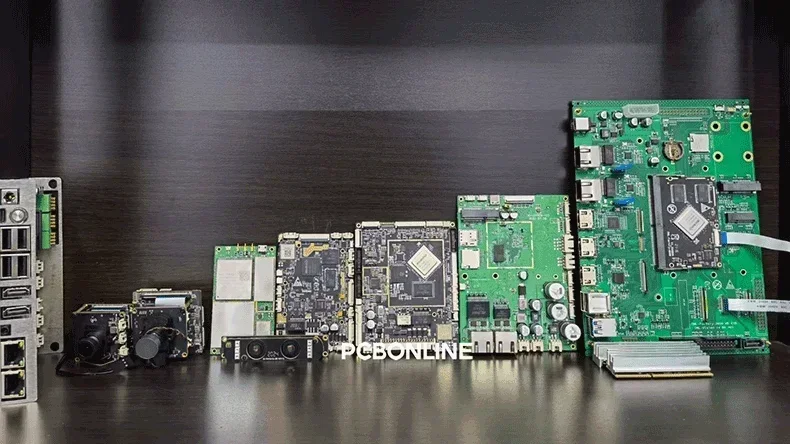
How do you design and create your Internet of Things (IoT) system? What are the applications of IoT? In this blog, you will see a guide about IoT system design and find a PCBA (printed circuit board assembly) manufacturer for building IoT systems. You can also find the applications of IoT for home automation, industrial, smart agriculture, biometric recognition, AI and robots.
What are the Applications of IoT

IoT systems are employed in diverse applications, enhancing efficiency, automation, and data-driven decision-making. Here are some prominent fields of IoT system applications:
- Home Automation: Smart homes use IoT devices to control lighting, security, heating, and appliances remotely.
- Industrial IoT (IIoT): IIoT automatizes production, monitoring, security, and logistics management.
- Smart Agriculture: IoT in agriculture monitors soil moisture, weather conditions, and crop health, leading to precision farming.
- Biometric Recognition: IoT devices for biometric identification enhance security in banking, workplaces, and public services.
- AI and Robots: IoT integration in AI and robotics facilitates autonomous machines capable of complex tasks and data analysis.
Below are the detailed applications of IoT systems that you can design.
Home automation IoT systems
- Smart switches, smart sockets
- Android system LCD screen, touch control screen
- Smart curtain motor control system
- Smart lawn mower
- Smart speakers, companion, and care robot
- Smart lighting system
- Home security monitoring system, anti-theft automatic alarm
- Smart door locks
- Smart plant watering equipment
- Thermostat
Industrial IoT (IIoT) systems
Industrial IoT systems are used for four main fields: data collection, data transmission, intelligent mobile travel, and detection and monitoring.
Data collection- Intelligent data collector/intelligent wearable
- Medical intelligent wearable equipment
- Industrial data transmission terminal DTU
- Embedded BUSing/LoRa module
- Wireless sensor
- LoRa sensor engineering
- Outdoor gateway
- Indoor gateway
- Edge computing gateway
- GPS tracking (fleet management)
- Transceiver module (module brand)
- Intelligent mobile travel
- Intelligent shared scooter
- Oil-to-electric motorcycle
- Anti-lost positioning module
- IOT shared riding module
- Forest fire detection
- Air quality detection equipment
- Wastewater discharge detection
- Scenic area/property management flow detection
- Intelligent anti-theft and alarm system
Smart agriculture technologies
- Fishery and animal husbandry population management equipment
- Intelligent weather station
- Animal intelligent trainer
- Grain storage temperature and humidity sensor module
- Animal GPS positioning
- Automatic irrigation system
- Intelligent farm electric shock fence
Biometric recognition solutions
- Fingerprint sensor module
- Fingerprint scanner
- Intelligent access control system
- Face recognition system
- Face recognition security check
- Automated customs clearance (face and palm print recognition)
AI and Robots
- Smart sweeping robot
- Smart transport drone
- Smart vending machine
- Unmanned driving (Lidar Products)
- Robotic arm control system
- Rescue and salvage robot
- Companion robot
- Elderly physical examination and telemedicine system
Now you know what the applications of IoT are. How to create and build an IoT system? You will need to design the IoT PCB board using the required components. Among the many components, MCUs and sensors are necessary. Get to know the powerful and cost-effective MCUs and sensors below.
MCUs and Sensors for IoT Design
The backbone of any IoT system consists of microcontrollers (MCUs) and sensors. Here, we introduce some MCUs that are powerful and affordable and some widely used sensors.
Microcontrollers (MCUs)

- ESP32: A versatile and powerful MCU with integrated Wi-Fi and Bluetooth, suitable for various IoT applications. It is known for its low power consumption and high performance.
- ESP8266: A cost-effective MCU with built-in Wi-Fi, widely used for simple IoT projects. It provides adequate processing power for many basic IoT applications.
- Neoway Modules: These modules support GSM, GPRS, and NB-IoT, making them ideal for cellular-based IoT applications. They are used in smart meters, asset tracking, and remote monitoring.
- Quectel Modules: These modules offer a range of cellular connectivity options, including LTE and 5G, and are used in automotive, industrial, and smart city applications.
- Fibocom Modules: Known for their reliability and extensive connectivity options, these modules are used in telematics, healthcare, and smart energy solutions.
Relying on an EMS factory, the one-stop PCBA manufacturer PCBONLINE has strategic cooperation with the above MCU companies and can source these MCUs at lower prices. If you need MCUs for your IoT system project, from PCBONLINE you can save budgets for your IoT PCBA manufacturing.
Sensors
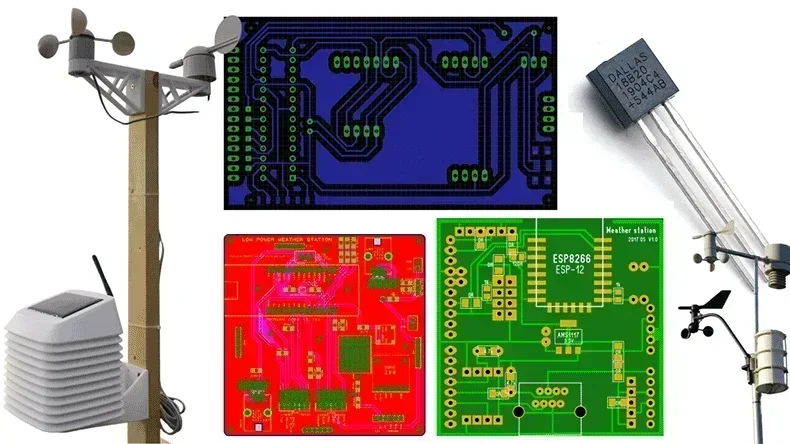
- DHT11 Sensor: A basic, low-cost digital temperature and humidity sensor. It provides reliable readings and is easy to interface with MCUs.
- BME280 Sensor: This sensor measures temperature, humidity, and barometric pressure, making it suitable for weather monitoring and indoor environmental sensing.
- HC-SR04 Ultrasonic Sensor: Used for distance measurement, it is commonly used in robotics, security systems, and level sensing applications.
- MQ Series Gas Sensors: These sensors detect various gases like CO, methane, and smoke and are used in environmental monitoring and industrial safety applications.
IoT System Design Easy Example: Humidity and Temperature Monitoring
How to design an IoT system? You can view an easy IoT system design process and know the basics. The below content explores the design of an IoT system that monitors humidity and temperature. This example uses an ESP32 microcontroller and a DHT11 sensor. The data is sent to the Arduino IoT Cloud in this IoT system design.
System Overview:
With the help of the ESP32's powerful processing power and integrated Wi-Fi module, this project collects environmental data from a DHT11/DHT22 sensor and sends it to the Arduino IoT Cloud. The Arduino IoT Cloud makes data visualization and remote monitoring easier, which offers a comprehensive platform for IoT solutions.
Hardware Components:
ESP32 Development Board: An adaptable microcontroller that incorporates Bluetooth and Wi-Fi.
DHT11/DHT22: Digital sensors for measuring temperature and humidity are called DHT11/DHT22 sensors.
Jumper wires and a breadboard are used for connection prototyping.
Power supply: The ESP32 should have the proper power supply.
Schematic diagram:
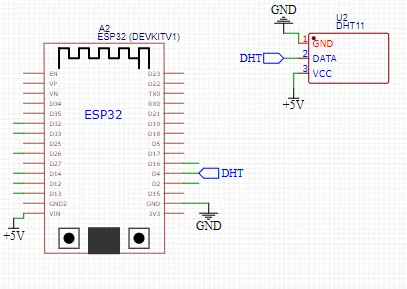
Hardware Setup:
Sensor to ESP32 Connections
DHT11/DHT22
VCC to 5V
GND to GND on ESP32
Data pin to GPIO 4 on ESP32
Software Configuration
Account and device registration: Open the Arduino IoT Cloud account by creating or logging in. To register your ESP32 device, follow the third-party device setup instructions.
Configuration of the thing: Within the Arduino IoT Cloud, create a new thing. Update the settings and add attributes for humidity and temperature with the necessary data types.
Code:
#include "thingProperties.h"
#include "DHT.h"
#include <DHT_U.h>
#define DHTTYPE DHT22 // Define the sensor type (DHT11 or DHT22)
#define DHTPIN 4 // Define the pin connected to the sensor
DHT dht(DHTPIN, DHTTYPE);
void setup() {
// Initialize serial communication
Serial.begin(115200);
// Initialize DHT sensor
dht.begin();
// Initialize cloud properties
initProperties();
// Connect to Arduino IoT Cloud
ArduinoCloud.begin(ArduinoIoTPreferredConnection);
// Wait for connection
while (ArduinoCloud.status() != ARDUINO_CLOUD_CONNECTED) {
delay(500);
Serial.print(".");
}
Serial.println("Connected to Arduino IoT Cloud");
}
void loop() {
// Update cloud properties
ArduinoCloud.update();
// Read sensor data
float newTemperature = dht.readTemperature();
float newHumidity = dht.readHumidity();
// Handle read failures
if (isnan(newTemperature) || isnan(newHumidity)) {
Serial.println("Failed to read from DHT sensor!");
return;
}
// Update cloud properties
if (newTemperature != temperature) {
temperature = newTemperature;
}
if (newHumidity != humidity) {
humidity = newHumidity;
}
// Log data to serial monitor
Serial.print("Temperature: ");
Serial.print(temperature);
Serial.print(" °C, Humidity: ");
Serial.print(humidity);
Serial.println(" %");
}
Details steps are given below:
Step 1. Create Arduino IoT cloud account.
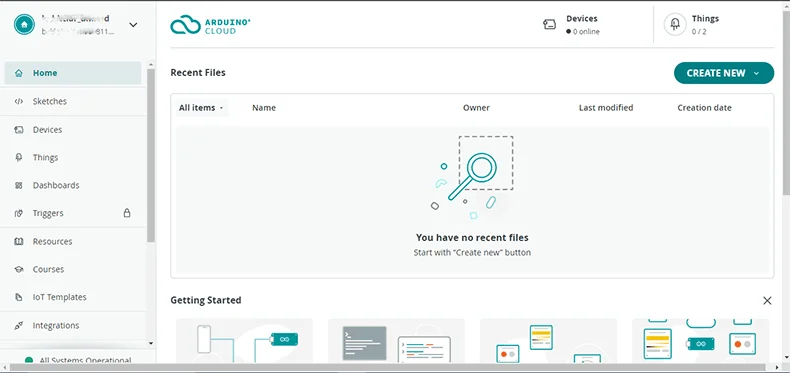
Step 2. Create a new thing in the Arduino IOT cloud account.
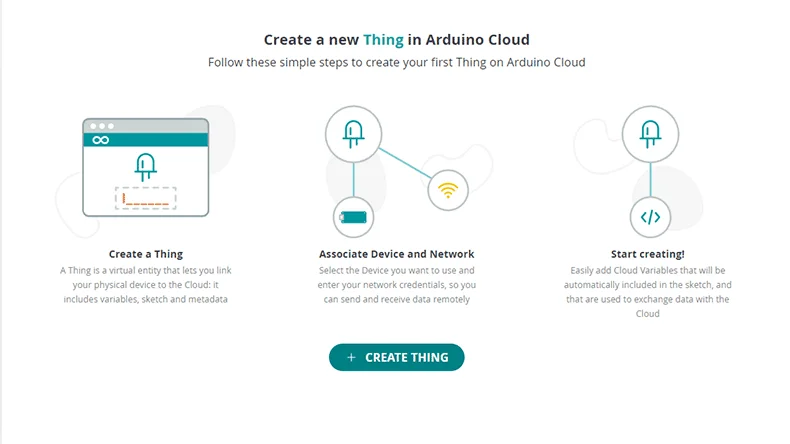
Step 3. Add humidity and temperature variables.
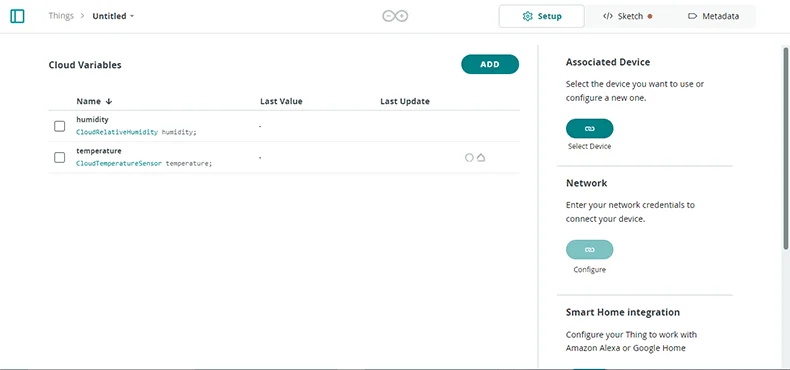
Step 4. Choose your device. In my case, I use the ESP32 Dev module.
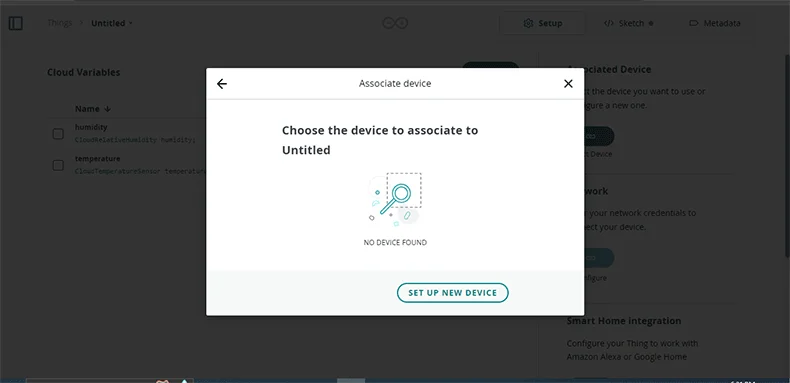
Step 5. Save the details for network configuration.
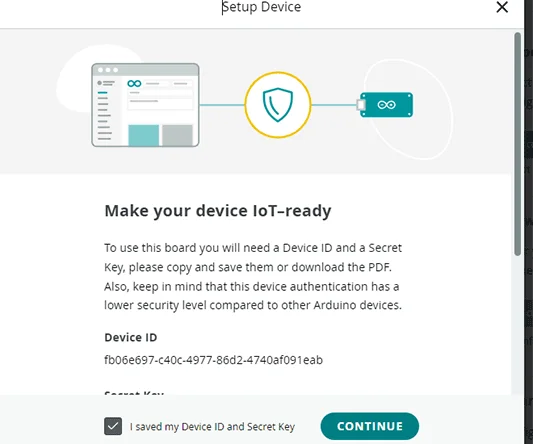
Step 6. Configure your network/Wi-Fi details also the secret key that you have saved in the previous steps.
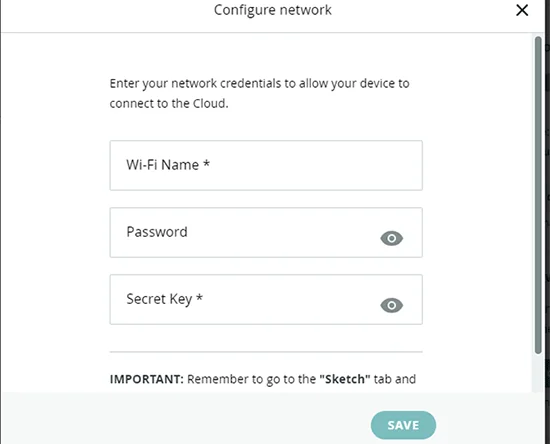
Step 7. Make widget settings for temperature and humidity.

Step 8. Add variables to widgets in your dashboard.
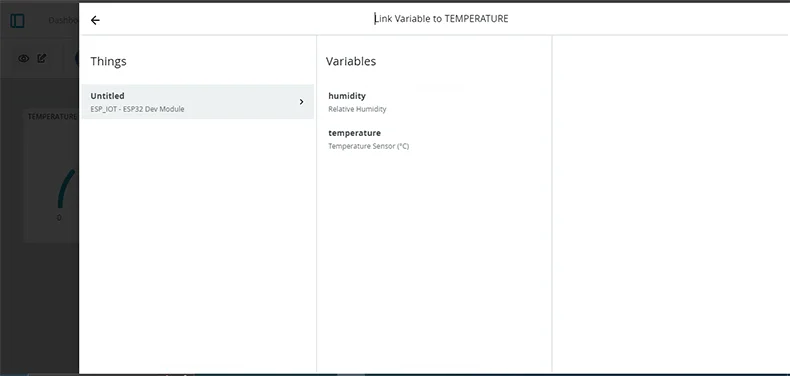
Step 9. Configure your code sketch and upload it to your ESP32 module.
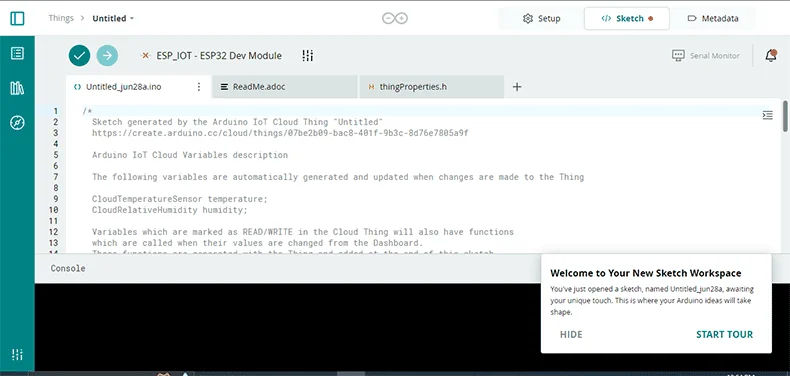
Step 10. Now you can see your temperature and humidity values in the dashboard.

This project uses the ESP32 to demonstrate how easily environmental monitoring can be integrated with the Arduino IoT Cloud. By leveraging the capabilities of the ESP32 and the Arduino IoT Cloud, engineers can develop scalable, reliable, and real-time monitoring solutions suitable for various industrial and environmental applications. Expansions like adding more sensors or integrating with other cloud services for additional functionality can be added to this project.
The above IoT system building project is only for demonstration and is easy. However, as an IoT PCBA manufacturer, we work on more advanced IoT systems for business, public, commercial, and industrial uses.
Work with IoT PCBA Manufacturer to Build Your IoT System at One Stop
How to build your IoT system from scratch to mass production? You can work with PCBONLINE, an IoT PCBA manufacturer with R&D and one-stop manufacturing capabilities.
PCBONLINE, founded in 1999, has two large advanced PCB manufacturing bases, one PCB assembly factory, reliable supply chains, and an R&D team. It has strategic cooperation in sourcing wireless MCUs for IoT systems with Espressif, Neoway, Quectel, and Fibocom.

PCBONLINE has IoT system development capabilities and can design the entire IoT System for you from an initial idea to real products, including the software and hardware R&D, PCB design, Gerber, BOM, manufacturing process and testing design, and the enclosure.
Powerful PCBA and electronics manufacturing capabilities and rich experience for any IoT system building under the roof, from prototypes/samples to scale manufacturing.
Affordable IoT PCB assembly and final product assembly as PCBONLINE is a source factory manufacturer and can source MCUs for IoT systems at lower costs.
High-quality IoT system PCBA manufacturing certified with IPC-A-610 Class 3, ISO 9001: 2015, IATF 16949: 2016, RoHS, REACH, and UL
PCBONLINE offers free DFM (design for manufacturing) and one-on-one engineering support to optimize your project and ensure the success of your IoT system before mass production.
When your IoT system project goes to the bulky manufacturing stage, PCBONLINE will refund your fees for R&D and product sampling and offer free PCBA functional testing.
PCBONLINE has developed and manufactured many IoT system projects, including industrial-grade and automotive-grade ones. To get a quote for your IoT system building, email info@pcbonline.com.
Conclusion
The Internet of Things (IoT) has revolutionized various fields by enabling smart, interconnected systems. This blog first lists the widely-used MCUs and sensors for IoT systems and then uses an easy example to show the IoT system design process. It also introduces an IoT PCBA manufacturer to build your IoT system and the applications of IoT. To design and build your IoT system from an initial idea and ensure your project can lead to successful results, work with the o IoT system PCBA manufacturer, PCBONLINE, who has R&D and one-stop manufacturing capabilities.
PCB assembly at PCBONLINE.pdf




